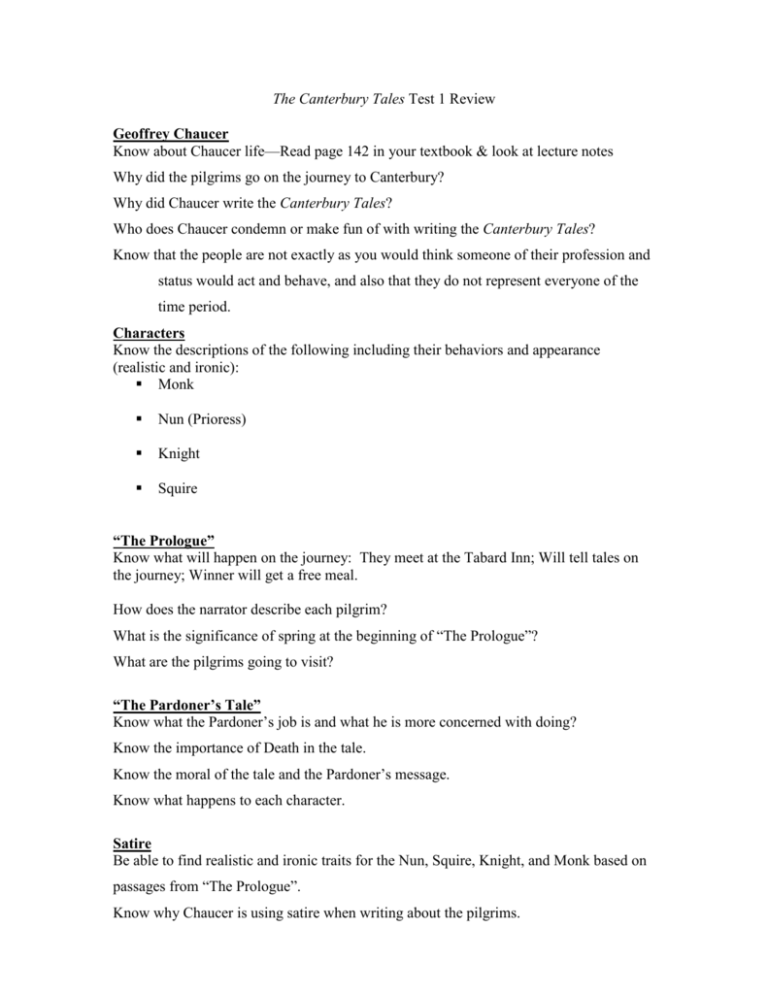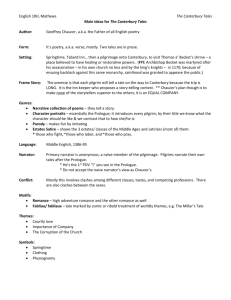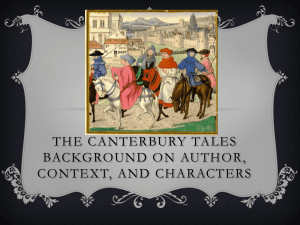The Canterbury Tales Test 1A
advertisement

The Canterbury Tales Test 1 Review Geoffrey Chaucer Know about Chaucer life—Read page 142 in your textbook & look at lecture notes Why did the pilgrims go on the journey to Canterbury? Why did Chaucer write the Canterbury Tales? Who does Chaucer condemn or make fun of with writing the Canterbury Tales? Know that the people are not exactly as you would think someone of their profession and status would act and behave, and also that they do not represent everyone of the time period. Characters Know the descriptions of the following including their behaviors and appearance (realistic and ironic): Monk Nun (Prioress) Knight Squire “The Prologue” Know what will happen on the journey: They meet at the Tabard Inn; Will tell tales on the journey; Winner will get a free meal. How does the narrator describe each pilgrim? What is the significance of spring at the beginning of “The Prologue”? What are the pilgrims going to visit? “The Pardoner’s Tale” Know what the Pardoner’s job is and what he is more concerned with doing? Know the importance of Death in the tale. Know the moral of the tale and the Pardoner’s message. Know what happens to each character. Satire Be able to find realistic and ironic traits for the Nun, Squire, Knight, and Monk based on passages from “The Prologue”. Know why Chaucer is using satire when writing about the pilgrims. Quotes: Know the following quotes and what each one means: Quote 1: When in April sweet showers fall/And pierce the drought of March to the root, and all/The veins are bathed in liquor of such power/As brings about the engendering of the flower,/When also Zephyrus with his sweet breath/Exhales an air in every grove and heath/Upon tender shoots, the young sun/His half-course in the sign of the Ram has run,/And small fowl are making melody/That sleep away the night with open eye/(So nature pricks them and their hearts)/Then people long to go on pilgrimages/And palmers long to seek the stranger strands/Of far-off saints, hallowed in sundry lands,/And specially, from every shires end/Of England, down to Canterbury they wend/To seek the holy blissful martyr quick/To give his help to them when they were sick. Quote 2: Thrice in the lists, and always killed his man./This same distinguished knight had led the van/Once with the Bey of Balat, doing work/For him against a heathen Turk;/He was of sovereign value in all eyes./And thought so much distinguished, he was was…/He was a true and gentle-knight./Speaking of his equipment, he possessed/Fine horses, but was not gaily dressed./He wore a fustian tunic stained and dark/With smudges where his armor had left his mark;/Just home from service he joined our ranks/To do his pilgrimage and render thanks. Quote 3: And she had little dogs she would be feeding/With roasted flesh, or milk, or fine white bread./And bitterly she wept if one were dead/Or someone took a stick and made it smart; She was all sentiment and tender heart./Her veil was gathered in a seemly way, /Her nose elegant, her eyes glass-gray;/Her mouth was very small, but soft and red,/Her forehead certainly, was fair of spread,/Almost a span across the brows, I own;/She was indeed by no means undergrown. Quote 4: Aye, and as loud as does the chapel bell,/Where my lord Monk was Prior of the cell./The Rule of good St. Benet or St. Maur/As old and strict he chose to ignore;/He let go the things of yesterday/And took the more spacious way. Quote 5: “The curse of avarice and cupidity/Is all my sermon, for it frees the pelf./Out come the pence, and specially for myself,/For my exclusive purpose is to win/And not at all to castigate their sin./Once dead what matter how their souls may fare?/They can go on blackberrying, for all I care!...” Short Answer 1. Describe how gold symbolizes Death in the story? 2. “’Do no more harm to an old man than you,/Being now young would have another do/When you are old’” Translate the quote from above and explain it’s significance. 3. Why do you think this story would be the pardoners most profitable? 4. Describe how Chaucer uses external physical descriptions to tell the reader about the character’s internal flaws. Use specific examples. 5. Which character in the “Prologue” does Chaucer seem to have the highest regard for? Use evidence to support your opinion. 6. What does the “Prologue” do to help the reader understand the tales that compromise the poem The Canterbury Tales? 7. Describe how the setting and the season contribute to the theme of The Canterbury Tales.








